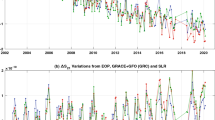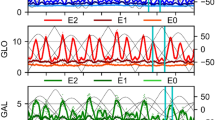Abstract
Accurate quantification of geocenter motion is important for maintaining the reference frame and estimating large-scale mass variations using the Gravity Recovery and Climate Experiment (GRACE) time-variable gravity solutions. Geocenter motion (equivalent to the variations in the degree-1 spherical harmonics of the gravity field) can be determined from different geodetic techniques and approaches, and the results generally show reasonable agreement, but significant differences still exist. To be more consistent with GRACE gravity solutions, here we present an improved approach to solve geocenter motion using GRACE GPS data. Over the past 15 years, GRACE satellites have acquired enough GPS data for studying the geocenter motion. In the meantime, data processing methods, reference system, and background geophysical models for GRACE precise orbit determination have also been significantly improved. Those aspects are very important for accurate determination of geocenter motion from GRACE GPS observations. For comparison, geocenter motion is also derived from LAGEOS satellite laser ranging (SLR) observations. With these independent geocenter motion solutions from GRACE GPS and LAGEOS SLR, we explore the reasons that lead to the differences between the solutions, and try to resolve these discrepancies. Daily geocenter motion time series from GRACE GPS data and 28-day geocenter variations from LAGEOS SLR observations for the time span 2003–2016 have been derived. Internal comparisons between the GRACE-A and GRACE-B geocenter motion time series and external comparisons between GRACE and LAGEOS show good agreements after using the improved approach. To verify the results, the annual geocenter motion from this study is compared with other recent geocenter motion solutions as well as predictions from geophysical models. The comparisons show reasonable agreements in both amplitude and phase with our improved approach.








Similar content being viewed by others
References
Altamimi Z, Collilieux X, Métivier L (2011) ITRF2008: an improved solution of the International Terrestrial Reference Frame. J Geod 85(8):457–473
Altamimi Z, Rebischung P, Métivier L, Collilieux X (2016) ITRF2014: a new release of the international reference frame modeling nonlinear station motions. J Geophys Res. https://doi.org/10.1002/2016JB013098
Beutler G, Rothacher M, Schaer S, Springer TA, Kouba J, Neilan RE (1999) The International GPS Service (IGS): an interdisciplinary service in support of earth sciences. Adv Space Res 23(4):631–635
Blewitt G, Lavalleé D, Clarke P, Nurutdinov K (2001) A new global mode of Earth deformation: seasonal cycle detected. Science 294(5550):2342–2345
Bouillé F, Cazenave A, Lemoine J, Crétaux J (2000) Geocentre motion from the DORIS space system and laser data on LAGEOS satellites: comparison with surface loading data. Geophys J Int 143(1):71–82
Case K, Kruizinga GLH, Wu SC (2010) GRACE level 1B data product user handbook, JPL D-22027. ftp://podaac.jpl.nasa.gov/allData/grace/docs/Handbook_1B_v1.3.pdf
Chen J, Wilson C, Eanes R, Nerem RS (1999) Geophysical interpretation of observed geocenter variations. J Geophys Res 104(B2):2683–2690
Cheng MK, Ries JC, Tapley BD (2013) Geocenter motion from analysis of SLR data. In: International Association of Geodesy symposia, vol 138, pp 19–25
Colliliéux X, Altamimi Z, Ray J, van Dam T, Wu X (2009) Effect of the satellite laser ranging network distribution on geocenter motion estimation. J Geophys Res. https://doi.org/10.1029/2008JB005727
Dong D, Dickey JO, Chao Y, Cheng MK (1997) Geocenter variations caused by atmosphere, ocean and surface ground water. Geophys Res Lett 24(15):1867–1870
Dong D, Yunk TP, Heflin MB (2003) Origin of the International Terrestrial Reference Frame. J Geophs Res Solid Earth 108(B4):2200
Dunn C, Bertiger W, Bar-Sever Y, Desai S, Haines B, Kuang D, Franklin G, Harris I, Kruizinga G, Meehan T, Nandi S, Nguyen D, Rogstad T, Thomas JB, Tien J, Romans L, Watkins M, Wu SC, Bettadpur S, Kim JR (2003) Instrument of GRACE: GPS augments gravity measurements. GPS World 14(2):16–28
Kang Z, Schwintzer P, Reigber C, Zhu SY (1997) Precise orbit determination for GPS/MET using GPS-SST data. In: Proceedings of the 12th international symposium on space flight dynamics, ESOC, Darmstadt, Germany
Kang Z, Tapley B, Bettadpur S, Ries J, Nagel P, Pastor R (2006) Precise orbit determination for GRACE mission using only GPS data. J Geod 80(6):322–331
Kar S (1997) Long-period variations in the geocenter observed from laser tracking of multiple Earth satellites, CSR report CSR-97-2, Center for Space Research, The University of Texas at Austin, Austin, TX, USA
König R, Dahle Ch, Vei M, Neumayer KH (2015) A geocenter time series from a combination of LAGEOS and GRACE observations. In: International Association of Geodesy symposia book series, IAG SYMPOSIA, vol 143, pp 169–174. https://doi.org/10.1007/1345_2015_24
Maennel B, Rothacher M (2017) Geocenter variations derived from a combined processing of LEO- and ground-based GPS observations. J Geod 91:933–944
Melachroinos SA, Lemoine FG, Zelensky NP, Rowlands DD, Luthcke SB, Bordyugov O (2013) The effect of geocenter motion on Jason-2 orbits and the mean sea level. Adv Space Res 51:1323–1334. https://doi.org/10.1016/j.asr.2012.06.004
Moreaux G, Lemonine F, Capdeville H, Kuzin S, Otten M, Stepanek P, Willis P, Ferrage P (2016) The International DORIS Service contribution to the 2014 realization of the International Terrestrial Reference Frame. Adv Space Res 58(7):1047–1064
Petit G, Luzum B (2010) IERS Conventions (2010), International Earth Rotation Service (IERS) Technical Note 36. Verlag des Bundesamts fur Kartographie und Geodasie, Frankfurt am Main
Ries JC (2016) Reconciling estimates of annual geocenter motion from space geodesy. In: Proceedings of the 20th international workshop on laser ranging, 10–14 Oct 2016, Potsdam, Germany. https://cddis.nasa.gov/lw20/docs/2016/papers/14-Ries_paper.pdf
Rim HJ (1992) TOPEX orbit determination using GPS tracking system, CSR report CSR-92-3, Center for Space Research, The University of Texas at Austin, Austin, TX, USA
Sun Y, Riva R, Ditmar P (2016) Optimizing estimates of annual variations and trends in geocenter motion and J2 from a combination of GRACE data and geophysical models. J Geophys Res 121:8352–8370
Swenson S, Chambers D, Wahr J (2008) Estimating geocenter variations from a combination of GRACE and ocean model output. J Geophys Res. https://doi.org/10.1029/2007jb005338
Tapley BD, Bettadpur S, Watkins M, Reigber C (2004) The gravity recovery and climate experiment: mission overview and early results. Geophys Res Lett. https://doi.org/10.1029/2004gl019920
Wu X, Colliliéux X, Altamimi Z (2010) Data sets and inverse strategies for global surface mass variations. Geophys Res Abstr 12:EGU2010
Wu X, Ray J, van Dam T (2012) Geocenter motion and its geodetic and geophysical implications. J Geodyn 58:44–61
Wu X, Abbondanza C, Altamimi Z, Chin TM, Colliliéux X, Gross RS, Heflin MB, Jian Y, Parker JW (2015) KALREF—a Kalman filter and time series approach to the International Terrestrial Reference Frame realization. J Geophys Res. https://doi.org/10.1002/2016jb011622
Wu X, Kusche J, Landerer FW (2017) A new unified approach to determine geocenter motion using space geodetic and GRACE gravity data. Geophys J Int 209:1398–1402
Acknowledgements
The authors would like to thank the International Global Navigation Satellite System (GNSS) Service (IGS) for providing the GPS ground station data and GPS satellite orbit products and the International Laser Range Service (ILRS) for the SLR data (https://ilrs.cddis.eosdis.nasa.gov/about/cite.html). This research was supported by NASA Contract NAS5-97213, NASA Grants NNX12AM86G, NNX17AG96G, NNX12AJ97G, and MEaSUREs-2018 (JPL Contract 1616713).
Author information
Authors and Affiliations
Corresponding author
Rights and permissions
About this article
Cite this article
Kang, Z., Tapley, B., Chen, J. et al. Geocenter motion time series derived from GRACE GPS and LAGEOS observations. J Geod 93, 1931–1942 (2019). https://doi.org/10.1007/s00190-019-01292-4
Received:
Accepted:
Published:
Issue Date:
DOI: https://doi.org/10.1007/s00190-019-01292-4




